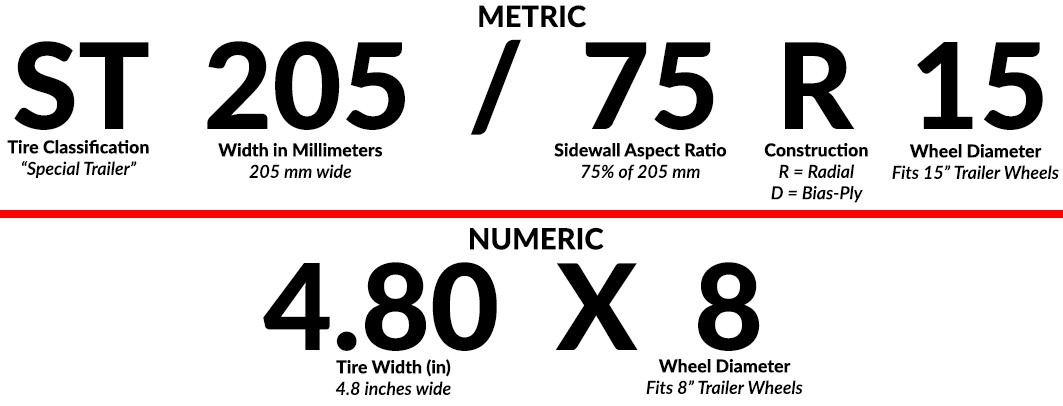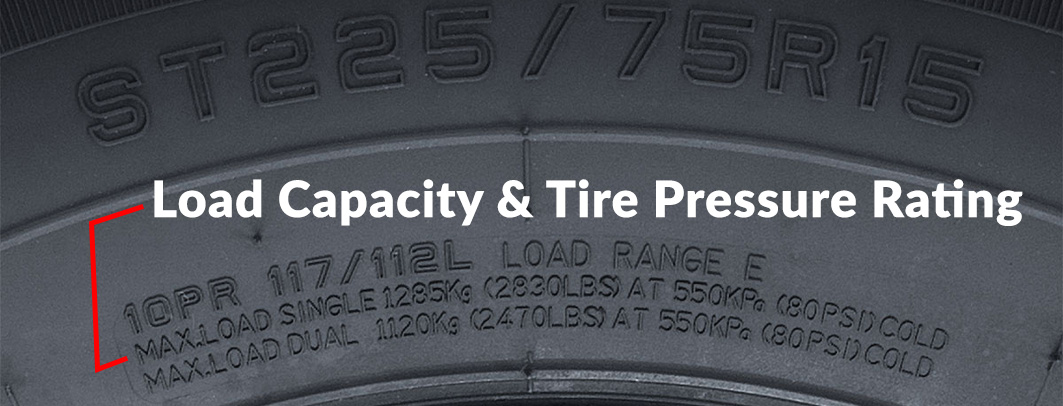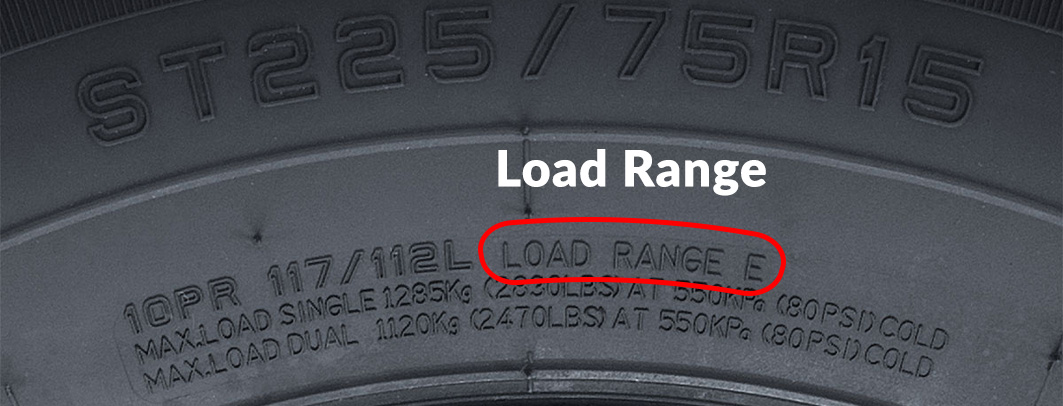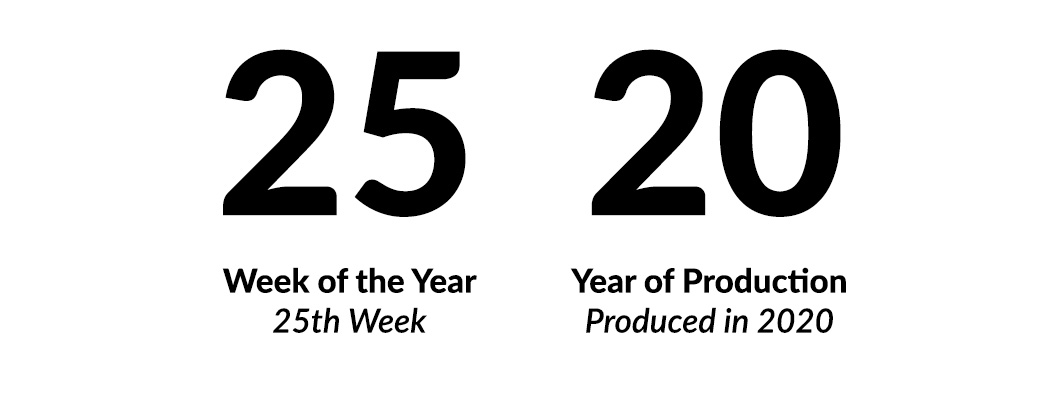A Guide to Understanding Trailer Tire Sidewall Information
We know that trying to figure out all of the different measurements, markings, and designations on the sidewall of your trailer tires can be confusing. However, the information on the side of your tire is there for a reason and it is important to understand for the safety of you and others around you. We have created this article to get you up to speed on all the information you need to know about your trailer tires.
Need Trailer Tires? Click Here to Shop Our Wide Selection!
Tire Sizing
The most prevalent measurement on a trailer tire will be the tire size. These dimensions are located on the tires sidewall and can be designated in metric or numeric formats. Metric sizing is most common on trailer tire sizes for 13” wheels and larger, while numeric sizing is most common on wheel sizes of 12” or smaller. Metric measurements will be quantified as “ST185/80D13” or “ST205/75R15”, for example. Numeric measurements are displayed as “4.80X8” or “5.30X12”. To understand these measurements, let's break them down.
Starting with metric sizing, we will explore the following tire size: ST205/75R15. The “ST” designation represents the class of vehicle the tire is used for and stands for “Special Trailer”. ST-designed tires should only be used for trailer applications. You may have seen tire sizes starting with “P” (Passenger) or “LT” (Light Truck), as these are for use on automobiles.
Moving on to our first set of digits, the “205” represents the width of the tire tread in millimeters. This tire will measure 205 millimeters in width.
Next, we find the tire’s Aspect Ratio, which in this case is “75”. The aspect ratio is actually a percentage value and measures the tire’s sidewall height. In this case, the tire’s sidewall is 75% of 205 millimeters or 153.75 mm tall.
Following the aspect ratio, we find a single letter which is used to represent the tire’s internal construction. In the case of our example tire, the “R” stands for Radial Construction. You may also find tires with the letter “D”, which stands for Diagonal or Bias-Ply. We will explore tire construction later in this article.
The last digit will represent the wheel size that the tire will fit represented in inches. For this tire, it will fit trailer wheels measuring 15 inches in diameter.
Now let's break down numeric sizing. We will use “4.80X8” as an example. The “4.80” represents the tire’s width in inches. In this case, the tire is 4.8 inches wide.
The next digit represents the wheel size the tire will fit. This tire is meant for trailer wheels that are 8 inches in diameter. While the numeric measurement style is simpler than metric, it provides less information about the tire.

Load Capacity/Index
A tire’s load capacity is crucial information for the user to know as it informs the user of the maximum amount of weight the tire can handle. Exceeding a tire’s load capacity will lead to tire failure and blowouts, which is a major safety concern for you and others around you. The load capacity/index will be represented in pounds on the tire’s sidewall. Always reference the load capacity/index before loading your trailer.
Max PSI
Knowing the maximum pressure for your trailer tires is critical for longevity and safety. It is recommended you run your trailer tires at the maximum pressure for best performance, as indicated on the tire’s sidewall in terms of Pounds Per Square Inch, or “PSI”, for short. Running your trailer tires over or far under the limit can cause excessive heat to build up, which drastically increases the risk of a blowout. Be sure to always check your trailer tire’s pressure before heading out on your next journey.

Load Range
A trailer tire’s Load Range will be represented by a letter on the tire’s sidewall. This designation indicates the tire's internal ply count and gives you a general idea of what the load capacity will be for that tire. A “B” load range tire will have a smaller load capacity, while an “E” load range tire will be for heavy-duty use. One of the most common trailer tire load ranges is the Load Range C, or “LRC”, for short. A C-rated trailer tire has a 6-ply construction and typically has a load capacity in the 1,500 lb range. Load Range designations provide important information, but always reference your tire’s exact load capacity/index before loading.

Speed Ratings
The Speed Rating for a trailer tire is typically represented by a single letter or exact speed printed on the tire’s sidewall. The speed rating is important to know before using your trailer as it informs the user on the maximum speed that tire can handle. Exceeding a tire’s speed rating may cause excess heat to build up in the tire and can lead to tire failure.
A trailer tire with a speed rating of “M” has a maximum speed rating of 81 MPH. Similarly, a rating of “L” means the tire is only rated for 75 MPH. If there is not a single letter representing the speed rating, the exact speed in miles per hour (MPH) should be printed on the sidewall.
Tire Construction
One of the most common questions we receive at RecStuff.com is “Which is better? Radial or Bias-Ply?” However, the answer is highly dependent on the use case. First, lets get an understanding on the differences between a Radial and a Bias-Ply tire.
A bias-ply tire is designated by the letter “D” in the tire’s metric size code and is comprised of internal tire plys made from steel and polyester that lay diagonally over each other at a 32-degree angle perpendicular to the tire's direction of travel. A bias-ply tire offers less flex than a radial tire and can usually be sourced for a cheaper price.
A radial tire is designated by the letter “R” in the tire’s metric size code and features an internal construction of steel belts running perpendicular to the tire's direction of travel at a 90-degree angle. This allows the tire to have more flex, run at a cooler temperature, and provide higher traction.
So which tire should you choose? Bias-ply tires provide durability over rough terrain but, have a higher risk of running hot on long trips and at higher speeds. If you use your trailer for short trips or over rough terrain, a bias-ply tire would be the right choice. If you run your trailer at higher speeds, at longer distances, and with higher weight, a radial tire would be a top choice. It is important to know that you should never mix bias-ply and radial tires. Each tire provides different handling characteristics and can cause serious danger if two different tire types are being utilized on the same trailer.
Date Codes
A tire’s lifespan is typically measured by tread depth, but that is not the only factor to consider. Over time, the rubber compound of a tire will start to degrade. Factors like temperature, inflation, and storage all play a role in how long a tire will last. For example, a tire stored outside and exposed to the elements will have a shorter lifespan than one stored in a climate-controlled environment. However, the exact lifespan of a tire can be difficult to predict with so many factors to consider. According to the Rubber Manufacturer Association (RMA) “Since service and storage conditions vary widely, accurately predicting the actual serviceable life of any specific tire based on simple calendar age is not possible” (Zielinski). While every tire is different and every manufacturer has their own recommendations, the average lifespan of a trailer tire is about 5 years in service, depending on the conditions the tire is exposed to.
To determine the age of a tire, reference the date code on the tire that will be located next to the “DOT” code near the wheel rim. The date code is usually only stamped on one side of the tire and would be represented as “0322” or “2520”. So what do these digits mean? Using “2520” as our example, we will split this code into two parts. The first two digits represent the week of the year this tire was made. In this case, the tire was made on the 25th week of the year. The next two digits, (20), represent the year the tire was made. In this case, the tire was made in the year 2020. By reading our date code, we can see the tire was made in the middle of June 2020.

Looking for replacement trailer tires? RecStuff.com is your place to find the perfect fit for your trailer!
Click here to see our full selection!
Source Cited: Zielinski, Dan. NTSB Tire Symposium - Tire Aging and Service Life
Recent Posts
-
Lawn and Garden Tire Information
Spring is here, which means it's time to bring out the lawn tractor and get the yard ready for warme …Mar 24th 2025 -
Snowmobile Trailer Tips
When the snow starts to fall, you may be itching to hop on your sled and hit the trails. However, be …Jan 6th 2025 -
Keep Your Golf Cart on Course - A Guide to Golf Cart Maintenance
Golf carts are a useful and convenient mode of transportation for leisure and for work …Sep 30th 2024




